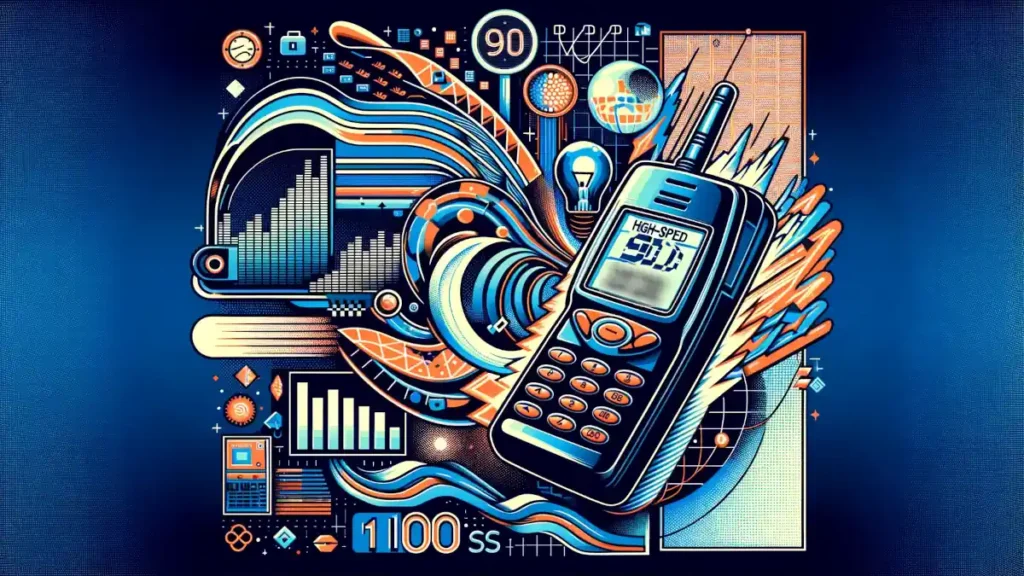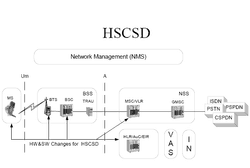Let’s rewind to the ’90s and explore a pioneering technology: High-Speed Circuit Switched Data, or HSCSD for the acronym lovers. Think of it as a stepping stone that paved the way for the lightning-fast connectivity we enjoy today. It may sound like a relic from the past, but trust me, understanding HSCSD is like reading the first chapter of an epic saga of mobile data evolution. So, let’s jump into our digital time machine and discover the roots of our current mobile internet – it’s a tale of innovation, challenges, and groundbreaking achievements that shaped the world of telecommunications!
Table of Contents:
- What is High-Speed Circuit Switched Data (HSCSD)?
- The Technicalities of HSCSD
- Historical Context and Significance
- Legacy and Transition to Newer Technologies
- References

1. What is High-Speed Circuit Switched Data (HSCSD)?
Alright, let’s dive into what High-Speed Circuit Switched Data, or HSCSD, really is. Picture the early days of mobile internet, where dial-up was king on landlines. HSCSD was the mobile world’s answer to ramping up data speeds, a kind of ‘dial-up deluxe’ for cell phones. Developed in the 1990s, HSCSD was one of the first technologies to enhance the data transmission capabilities of existing cellular networks.
In essence, HSCSD is an extension of the Circuit Switched Data services in GSM networks. But here’s the cool part: it combined multiple GSM channels. Think of it like merging several slow-moving traffic lanes into a high-speed express lane. This merging of channels allowed for faster data transfer rates compared to standard GSM data services.
So, how fast are we talking? While traditional GSM data services offered speeds of around 9.6 kbps (kilobits per second), HSCSD could boost this up to 57.6 kbps. Now, I know what you’re thinking – that’s snail-paced compared to today’s 4G and 5G speeds. But back then, it was groundbreaking. It meant quicker browsing, faster downloads, and a glimpse into the potential of mobile internet.

The key takeaway? HSCSD marked a significant step forward in the quest for speed in mobile data services. It set the stage for future advancements by showcasing that higher data rates were possible on existing network infrastructures. So next time you’re streaming HD videos on your smartphone, spare a thought for HSCSD – the unsung hero that helped kickstart the high-speed mobile data revolution!
2. The Technicalities of HSCSD
Let’s get technical and break down how HSCSD actually worked. At its core, HSCSD was an enhancement of the existing GSM (Global System for Mobile Communications) network. GSM initially allowed for circuit-switched data transfer, which essentially meant setting up a dedicated circuit for each communication session.
The innovation with HSCSD was its ability to ‘bundle’ multiple GSM channels together. Typically, a GSM channel had a data rate of 9.6 or 14.4 kbps. HSCSD could combine up to four of these channels for downlink (from the network to the device), ramping up the maximum data transfer rate to around 57.6 kbps. For uplink (from the device to the network), it could use two channels, offering up to 28.8 kbps.
But here’s the catch – HSCSD’s performance depended heavily on network conditions and the number of available channels. This bundling of channels also meant that HSCSD was using resources that could otherwise handle multiple individual calls, making it less efficient in terms of resource utilization.
Moreover, HSCSD required both the mobile device and the network to support the technology, which meant upgrades on both ends. This limitation was one of the reasons why HSCSD was more of a transitional technology, bridging the gap between the basic GSM and the more advanced, packet-switched technologies that followed.
3. Historical Context and Significance
Rewind to the 1990s, and the internet was just starting to rev up. Dial-up connections ruled the desktop world, and mobile internet was in its infancy. The introduction of HSCSD happened in this environment, where the hunger for faster, more efficient mobile data solutions was growing.
Before HSCSD, mobile internet was primarily limited to GSM’s Circuit Switched Data (CSD). CSD was slow, offering data rates of just 9.6 kbps. It was fine for text-based services like SMS, but as the internet started to become more graphics-intensive, it quickly became inadequate.
Enter HSCSD. Its introduction was a significant milestone because it demonstrated that higher data transfer rates were feasible, even within the constraints of existing cellular technology. It paved the way for GPRS (General Packet Radio Service) and EDGE (Enhanced Data rates for GSM Evolution), which introduced packet-switching to mobile networks, allowing for even faster and more efficient data transfer.
HSCSD’s significance lies in its role as a trailblazer. It was a critical stepping stone that showed the world what mobile internet was capable of and set the stage for the high-speed, always-on mobile data services we take for granted today. So, while HSCSD might not have lasted long in the limelight, its impact on mobile communication technology was undeniably profound.
4. Legacy and Transition to Newer Technologies
As we reflect on the legacy of HSCSD, it’s crucial to recognize how it laid the groundwork for the mobile data revolution that followed. HSCSD was a key player in the transition from the basic, voice-centric GSM networks to the data-dominant systems we see today.
The transition from HSCSD began with the introduction of GPRS (General Packet Radio Service). GPRS was a game-changer because it introduced the concept of packet-switching to mobile networks. Unlike HSCSD’s circuit-switching, which dedicated a specific channel for each connection, packet-switching allowed data to be broken into packets and transmitted over various channels. This meant more efficient use of network resources and higher data speeds.
Following GPRS, EDGE (Enhanced Data rates for GSM Evolution) came into play, further increasing data transmission speeds and marking a significant step towards 3G technologies. EDGE was essentially a souped-up version of GPRS, providing better data rates and improved network efficiency.
The leap to 3G and later 4G technologies was monumental. 3G brought about much faster data transmission, improved capacity, and better support for multimedia services. Then, 4G took things to the next level with LTE (Long-Term Evolution), offering speeds that made mobile internet not just a convenience, but a viable replacement for many wired broadband connections.
Today, as we venture into the era of 5G, we’re looking at even more incredible speeds, lower latency, and the capacity to connect a vast number of devices. It’s a far cry from the days of HSCSD, but the path was undeniably shaped by those early advancements. HSCSD, in its own way, was a pioneer, pushing the boundaries of what was possible and setting the stage for the high-speed, hyper-connected world we’re stepping into.
5. References
- “Wireless Communications: Principles and Practice” by Theodore S. Rappaport.
- “Mobile Communications” by Jochen Schiller.
- “The GSM System for Mobile Communications” by Michel Mouly and Marie-Bernadette Pautet.
- RFC 1144 – Compressing TCP/IP Headers for Low-Speed Serial Links.
- “3G, 4G and Beyond: Bringing Networks, Devices and the Web Together” by Martin Sauter.
- “Introduction to 4G Mobile Communications” by Juha Korhonen.